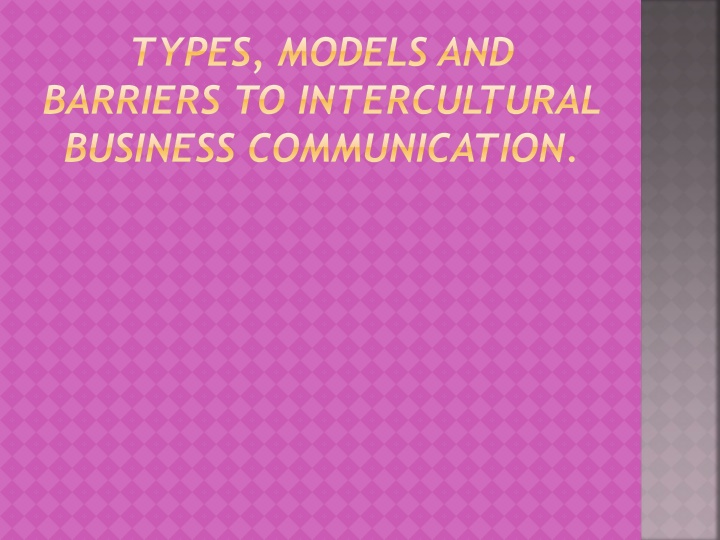
Intercultural Business Communication: Types, Models, and Barriers
Gain insights into different types, models, and barriers of intercultural business communication. Explore how senders encode information, the linear communication model, decoding processes, and factors like noise and personal filter areas that affect effective communication.
Download Presentation

Please find below an Image/Link to download the presentation.
The content on the website is provided AS IS for your information and personal use only. It may not be sold, licensed, or shared on other websites without obtaining consent from the author. If you encounter any issues during the download, it is possible that the publisher has removed the file from their server.
You are allowed to download the files provided on this website for personal or commercial use, subject to the condition that they are used lawfully. All files are the property of their respective owners.
The content on the website is provided AS IS for your information and personal use only. It may not be sold, licensed, or shared on other websites without obtaining consent from the author.
E N D
Presentation Transcript
TYPES, MODELS AND BARRIERS TO INTERCULTURAL BUSINESS COMMUNICATION.
COMMON ELEMENTS Sender encodes information as a Message which is sent via a Channel (email, letter, report, etc.) to a Receiver who decodes the information Feedback completes the loop & the process continuous until understanding is achieved Noise - any forces that interfere with effective communication Personal filter areas - the commonness of the encoding and decoding processes
LINEAR MODEL this linear model, communication is like giving an injection: a sender encodes ideas and feelings into some sort of messages and then conveys them to a receiver who decodes them. communication In
A sender is a person who starts the communication. A sender is someone who needs and wants to exchange information with others. A message is the verbal and/or nonverbal form of ideas, thoughts or feelings that one person wishes to communicate to another person or in some place at some time within a specific context.
Communication channel the method by which a message is conveyed between people. Encoding the process of taking the sender s ideas and translating them into a set of symbols. Encoding is the action of transforming information into words. information and
Decoding is the process of translation and interpretation of the message by the receiver. A receiver is the person who receives and decodes the message. Feedback is information generated by the receiver and made available to the sender, allowing the sender to judge the communication while it is taking place.
Noise a term used by social scientists to describe any forces that interfere with effective communication. Personal filter areas. One of the keys of effective communication commonness of the decoding processes. If the senders and receivers use very different encoding and decoding processes, communication will result. In short, good communication depends upon the sender and receiver speaking the same language. is the and encoding then poor
TRANSACTIONAL MODEL The transactional model reflects the fact that we usually send and receive messages simultaneously. The role of sender and receiver that seemed separate in the linear model are now superimposed and redefined as those of communicators . This new term reflects the fact that at a given moment we are capable of receiving, decoding, and responding to another person s behavior, while at the same time that other person is receiving and responding to ours.
CONCLUSION A linear and a transactional communication models were developed, demonstrating the superiority of the transactional model in representing the process-oriented nature of human interaction. The transactional nature of relationships is worth reemphasizing: We don t communicate communicate with them. And now you can see that a transactional communication should be more a motion picture film than photographs. others, we to model of a gallery of still
